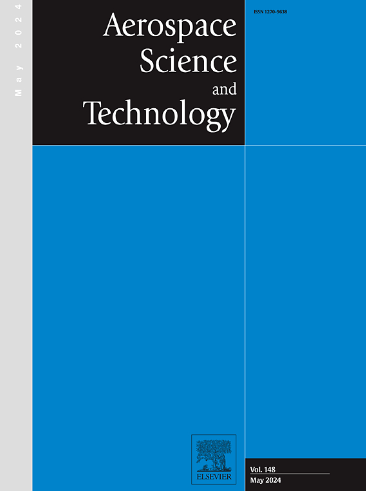Krueger襟翼气动声学评价及机理研究
IF 5.8
1区 工程技术
Q1 ENGINEERING, AEROSPACE
引用次数: 0
摘要
高升力装置产生的噪音是飞机进近和降落时噪音的主要来源。大多数已发表的关于高扬程设备噪声的研究都集中在板条配置上,并采用降噪措施来减轻板条噪声,例如垂鼻设备或长弦板条设备。层流机翼技术的另一种替代方案是克鲁格前缘襟翼。在这项研究中,通过数值模拟分析了高升力克鲁格襟翼构型的流场、噪声源和详细特性,包括基线配置和没有克鲁格存储腔的配置。采用Ffowcs williams - hawkins方程计算远场噪声传播。结果表明,带空腔的基线构型在低频表现出较强的音调噪声,而空腔对克鲁格襟翼噪声的影响主要表现为中高频范围内的宽带噪声。研究了迎角变化对总噪声的影响,发现迎角的变化对克鲁格襟翼及其槽区周围的流场有显著影响。然而,空腔对下游流场和噪声的影响并不显著。值得注意的是,在特定迎角下观察到克鲁格襟翼噪音的大幅减少,这是研究实际飞机噪音的一个重要因素。本文章由计算机程序翻译,如有差异,请以英文原文为准。
Aeroacoustics evaluation and mechanism of Krueger flap
Noise generated by high-lift devices is a major contributor to aircraft noise during approach and landing. Most published research on high-lift device noise focuses on slat configurations, with noise reduction measures applied to mitigate slat noise, such as droop nose devices or long-chord slat devices. Another alternative for laminar-flow wing technology is the Krueger leading-edge flap. In this study, numerical simulations were conducted to analyze the flow field, noise sources, and detailed characteristics around a high-lift Krueger flap configuration, including both a baseline configuration with a Krueger storage cavity and a configuration without the cavity. Far-field noise propagation was calculated using the Ffowcs Williams-Hawkings equation. The results indicate that the baseline configuration with the cavity exhibited strong tonal noise at low frequencies, while the cavity's influence on the Krueger flap noise was primarily in the form of broadband noise within the mid-to-high frequency range. The impact of angle-of-attack variations on overall noise was also studied, revealing that changes in the angle of attack significantly affected the flow field around the Krueger flap and its slot region. However, the impact of the cavity on the downstream flow field and noise is not significant. Notably, a substantial reduction in Krueger flap noise was observed at specific angles of attack, which is a factor that is essential in the study of noise associated with actual aircraft.
求助全文
通过发布文献求助,成功后即可免费获取论文全文。
去求助
来源期刊

Aerospace Science and Technology
工程技术-工程:宇航
CiteScore
10.30
自引率
28.60%
发文量
654
审稿时长
54 days
期刊介绍:
Aerospace Science and Technology publishes articles of outstanding scientific quality. Each article is reviewed by two referees. The journal welcomes papers from a wide range of countries. This journal publishes original papers, review articles and short communications related to all fields of aerospace research, fundamental and applied, potential applications of which are clearly related to:
• The design and the manufacture of aircraft, helicopters, missiles, launchers and satellites
• The control of their environment
• The study of various systems they are involved in, as supports or as targets.
Authors are invited to submit papers on new advances in the following topics to aerospace applications:
• Fluid dynamics
• Energetics and propulsion
• Materials and structures
• Flight mechanics
• Navigation, guidance and control
• Acoustics
• Optics
• Electromagnetism and radar
• Signal and image processing
• Information processing
• Data fusion
• Decision aid
• Human behaviour
• Robotics and intelligent systems
• Complex system engineering.
Etc.
 求助内容:
求助内容: 应助结果提醒方式:
应助结果提醒方式:


